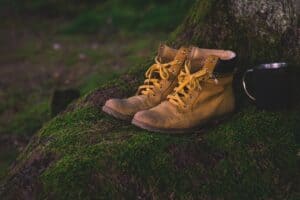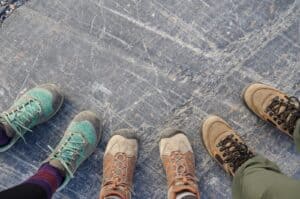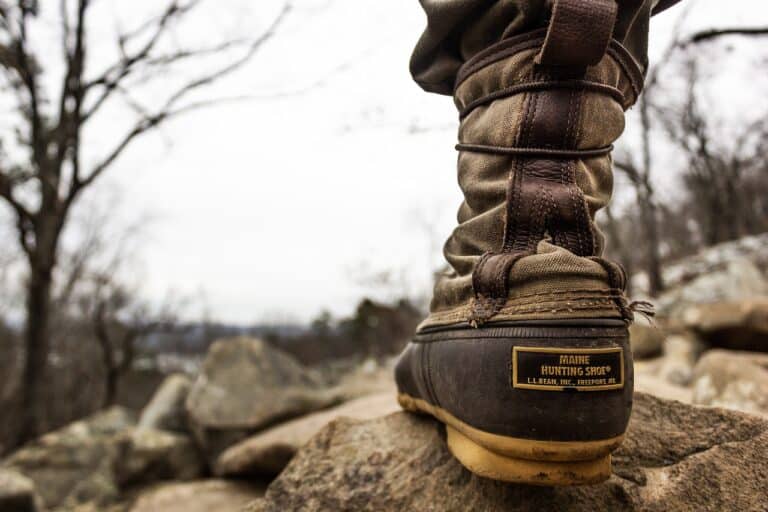When it comes to hiking, the right pair of shoes can make or break your experience. I’ve learned this the hard way. But don’t worry, I’m here to share my knowledge so you don’t have to go through the same trials and tribulations.
In this article, I’ll be sharing key hiking shoes tips for choosing the perfect hiking shoes. We’ll delve into the importance of the right fit, material, and style. Plus, we’ll explore how to properly care for your hiking shoes to extend their lifespan.
So, if you’re planning your next outdoor adventure or simply looking to upgrade your old hiking boots, you’re in the right place. Get ready to step into the world of hiking shoes with confidence and ease.
Importance of Choosing the Right Hiking Shoes

When it comes to hitting the trails, the right pair of hiking shoes can make or break your experience. They are not merely an accessory, but a vital part of your hiking gear and overall safety.
Your feet do most of the work during a hike. Hence, they deserve the utmost care and comfort. Opting for ill-fitting or poor-quality footwear can result in discomfort or injuries, turning a fun-filled outdoor adventure into a grueling ordeal.
By selecting the perfect pair of hiking shoes, you ensure that your feet remain snug, secure, and blister-free, even during long and arduous treks. They provide excellent foot and ankle support, critical for traversing steep or uneven terrains. An added bonus is the prevention of sprains or twists, which can be quite common on strenuous treks.
Choosing the right hiking shoes involves several factors, such as:
- Fit: The most crucial aspect, a well-fitting shoe should feel snug but not too tight, leaving enough room for your toes.
- Material: Opt for materials that are both durable and breathable. Synthetic materials, leather, and waterproof materials are common options.
- Style: Hiking shoes come in a variety of styles and designs each designed for different types of hikes.
Spending time and effort on finding the right shoe for your needs is undeniably a smart move. When you’re a few miles in on a challenging trail, your feet will surely thank you.
Ensuring proper care for your hiking shoes helps extend their lifespan, enabling you to enjoy many more adventures with them. Regular cleaning, timely repairment, and appropriate storage go a long way in maintaining the efficacy of your footwear.
Remember, a rewarding hiking experience starts from the ground up. Your shoes lay the groundwork for comfort, safety, and enjoyment on the trails. Investing in the right pair is an investment in your love for the great outdoors.
Finding the Perfect Fit

When it comes to hiking shoes, fitting is critical. A good fit can enhance your hiking experience whereas a bad one could potentially lead to a grueling journey or even injuries. So, how exactly do you determine the perfect fit for your hiking shoes? Allow me to shed some light on the simple yet crucial process.
Firstly, consider the time of day when you’re trying on new shoes. Feet can swell a little throughout the day, reaching their largest size by the afternoon. Therefore, shopping for new hiking shoes in the afternoon or early evening will provide a more accurate fit.
Next, remember that socks matter. Most of us wear thicker socks for hiking than we do in daily life. Try on hiking shoes with the same thickness of socks you’ll be wearing on trails. It’ll give you an idea of the exact fit you’d need in different hiking conditions.
Onto the shoes themselves. Hiking boots should be snug everywhere, tight nowhere, and provide room to wiggle your toes. Once you’ve got them on, try to replicate hiking movements in the store. Walk uphill and down, step on inclines, and so on.
Take note of any uncomfortable spots, rubbing, or looseness. Hiking shoes that apply too much pressure to a specific area can cause discomfort while those too loose might lead to blisters. There should be no pressure points and enough room for your foot to move and breathe but not too much to lose stability and control.
Don’t be afraid to take time trying on multiple sizes and styles. The perfect fit might not always come with the first pair you try. It’s far more important to find a pair of hiking shoes that feel comfortable and secure than sticking to a specific shoe size or style. Remember, no two feet are identical, so trust your feel more than the size chart.
Lastly, don’t make the common mistake of thinking the shoes will “break in” after a few hikes. A good pair of hiking shoes should feel comfortable from the start. Uncomfortable shoes can turn hiking into a painful endeavor.
Investing time and patience in finding the right pair of hiking shoes is more than worth it. After all, these are the shoes that’ll carry you through miles of amazing adventures.
The Best Materials for Hiking Shoes

True, the ideal fit governs your hiking shoe choice. But let’s turn the spotlight to the materials. You see, it isn’t just about getting the shoe that fits like a glove. It’s the materials that provide the longevity, function, and comfort for your hiking journey.
I’m tackling the most common materials for hiking shoe uppers. I’m talking about synthetics, split-grain leather, and full-grain leather.
Synthetic materials, including polyester, nylon, and synthetic leather, are commonly used. Their impact? Lightweight, quick-drying, and more affordable. However, they may not be as durable compared to leather materials. Continual use might wear them down faster.
Here’s another option that balances affordability and durability– split-grain leather. Typically paired with synthetic materials, it’s lighter and more breathable than full-grain. However, the flip side is it’s not as water or abrasion-resistant.
Your third option is full-grain leather. It’s tough, excellent in water and abrasion resistance. It’s the go-to if you’re planning to hike on rugged terrains or carry heavy loads. Remember, though, it’s heavier and lacks breathability. Therefore, it’s not recommended for light, quick hikes or in warm conditions.
Picking materials for hiking shoe uppers isn’t a one-size-fits-all. It’s a balancing act between the hiking conditions you’re likely to confront and your personal comfort levels. Whichever you choose, ensure that it aligns with your needs and preferences. After all, equipped with the right pair of hiking shoes, you’re one step closer to conquering those scenic trails.
Stay tuned, and we’ll unveil more about sole materials and constructions in the subsequent sections of our hiking shoe guide.
Choosing the Right Style for Your Hiking Needs
The right hiking shoe not only fits your foot but also aligns with your hiking style and trail conditions. Different styles cater to varied hiking needs like lightweight hiking, long-distance trekking, or even casual strolls in the park.
For example, lightweight shoes are ideal for day hiking or backpacking, where you may not be carrying a lot of weight. These shoes possess a balance of comfort and durability without being overly cumbersome. Remember, when you’re getting ready to start your day early, you want something that’s light and breezy on your feet.
On the other hand, long-distance hiking shoes, more commonly known as ‘backpacking boots’, are perfect if you’re expecting to encounter hard terrains or be traversing long distances with heavy weights on your back. These are specifically designed to offer superb ankle support and increased durability. It’s all about striking the balance between sturdiness and comfort.
Maybe you’re less into hard treks and more into casual strolls in the woods. Then, a pair of casual hiking shoes would be your go-to. They’re generally more breathable and flexible, making them perfect for weekend walks and quick trips to natural parks.
While no shoe type is a one-size-fits-all solution, it’s crucial to find what works for your personal hiking style and terrain. Consider your needs, assess the features of the shoe you’re eyeing, and decide based on what will provide you with the most comfort and durability for your hikes.
- Lightweight hiking shoes: Best for day hiking or backpacking.
- Long-distance hiking shoes: Suited for hard terrains and heavy loads.
- Casual hiking shoes: Perfect for light strolls and weekend walks.
Let’s proceed to look further into the importance of lacing techniques and how different methods can impact your hiking experience. Bear in mind, regardless of your shoe type, the right lacing can make a world of a difference.
Proper Care and Maintenance for Hiking Shoes

Once you’ve invested time, money and patience in finding the perfect pair of hiking shoes, it’s absolutely crucial to care for them correctly. Proper shoe care not just extends the life of your shoes, but also retains their performance and comfort.
Cleaning your hiking shoes should be a priority after each hike. Debris like dirt or pebbles can wear down the material, especially the outsoles and uppers. Don’t let your shoes sit around dirty, it’s advisable to clean them within 24 hours of your hike.
Here’s a quick guide on how to clean your hiking shoes:
- Gently remove any dirt or pebbles, using a soft brush or a damp cloth.
- If necessary, use some warm water and a gentle, bleach-free detergent.
- Never use aggressive cleaning methods, like a high-pressure water hose.
- Allow your shoes to air dry, out of direct sunlight.
- Don’t expose them to a heat source like a radiator or dryer as it can damage the material.
While cleaning is essential, proper storage isn’t to be ignored either. Store your hiking shoes in a well-ventilated, temperate area, avoiding extreme temperature fluctuations. Remember, damp, wet shoes can breed bacteria and fungi which lead to unwanted odors.
Regular checks are key. Look at the lacing system, the outsole, the upper material and the inside of the shoe to detect wear or damage. If there’s significant wear or discomfort, consider getting your shoes repaired or replaced.
Lastly, treating your shoes with specialist products can be beneficial. Products like water-repellent sprays or conditioners for leather shoes maintain performance against external elements.
Remember, the right investment in proper care and maintenance won’t just prolong the life of your shoes, it’ll also make a significant difference to your overall hiking experience.
Conclusion: Hiking Shoes Tips
I can’t stress enough how crucial it’s to pick the right hiking shoes. They’re your foundation, your support system, and your comfort on the trails. Finding the perfect fit and understanding the materials used in your shoes will make all the difference.
Remember, the style of your hiking shoes should match your hiking needs. Treating them right with proper care and maintenance will not only prolong their life but also enhance your hiking experience. It’s an investment worth making.
So, lace up your well-chosen, well-cared-for hiking shoes and hit the trails with confidence. Happy hiking!

